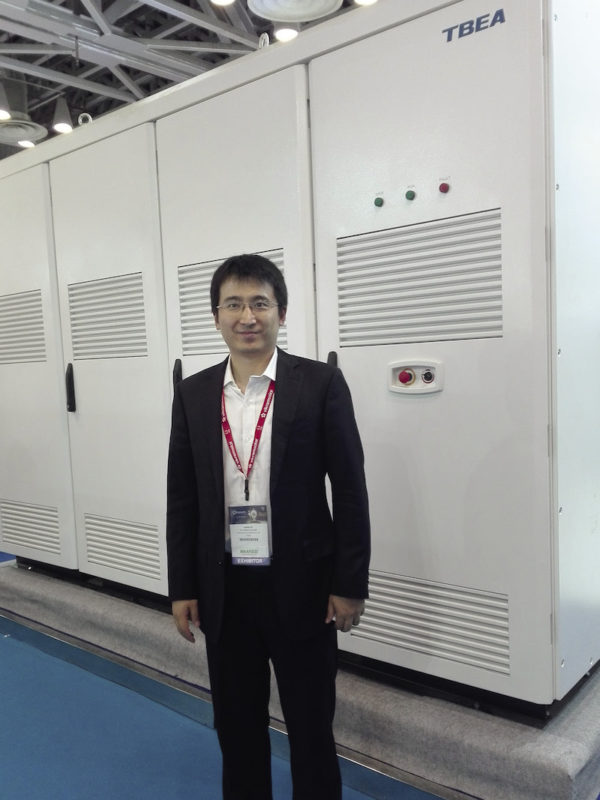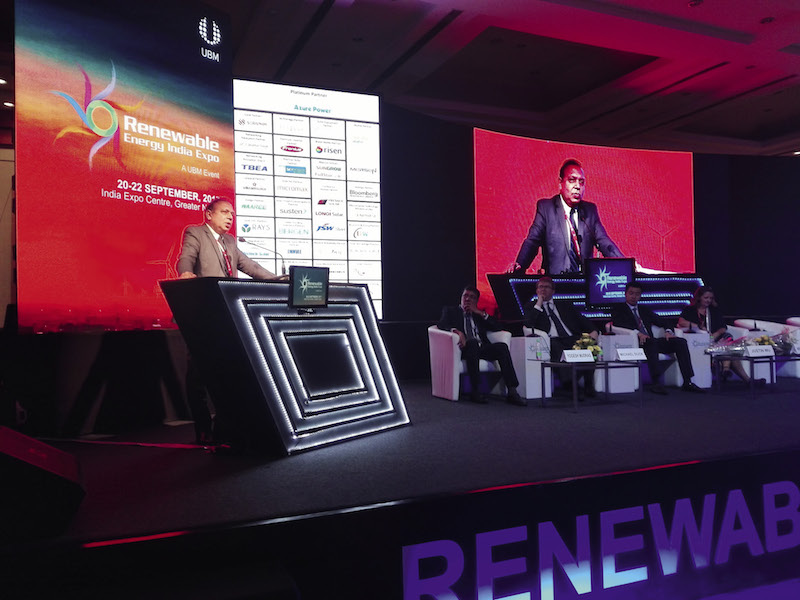“Today, a silent revolution is taking place in India’s renewable energy sector.” These were the words spoken by Shri Anand Kumar, the Secretary of India’s Ministry of New and Renewable Energy (MNRE) at the opening ceremony of the 11th Renewable Energy India (REI) Expo. Amid the hubbub of the hundreds of taxis pulling up outside, the hustle of the crowds all straining to collect their exhibition badges, and the blare and dazzle of the lights and sound system that ushered the attendant dignitaries on stage to open the show, the word “silent” felt slightly jarring, inaccurate even.
India is a unique country in a number of ways, and while silence and solitude can certainly be found in the foothills of the Himalayas or the temples of Tamil Nadu, here in Greater Noida – a perennially rushed, unfinished satellite city perched on the shoulder of Delhi – silence is a rare commodity.
Feeling the room, Kumar felt compelled to expand upon his words: “India is 17% of the world’s population, but consumes just 4.7% of the world’s electricity. Per capita energy consumption is around one third of the global average, and one eleventh of that of the U.S.”
But these figures are slowly changing. Not via the crash and bang of heavy investment in coal or petroleum, but with the light touch of solar PV and the wisp of wind power. By now, most solar observers can probably recount India’s 2022 renewable energy goal blindfolded (to recap: 175 GW of clean energy by that date, of which 100 GW is to be solar), but those figures do tend to serve as a front for the activity happening on the ground.
Naoki Tokotake, the Director General of the Japan Institute of International Affairs, made the pertinent point that for India, “it is not rational to meet necessary net increases in energy with fossil fuels” – a point expanded upon by Bloomberg New Energy Finance’s (BNEF) Justin Wu, who is head of the Asia Pacific region.
“India will invest $643 billion in wind and solar energy until 2040, which is almost $30 billion a year and around half of India’s total power generation investment,” he said. If followed through, this could mean that India has 670 GW of PV installed by that date, making solar India’s primary power source. Attaining that goal is by no means plain sailing, of course. “India faces the most competitive auctions the world has ever seen,” Wu cautioned. “It is a headache for independent power producers, financiers, and off-takers trying to sign a stable PPA. Rapid growth of renewables will also present challenges to the grid, but also opportunities for energy regulators and battery manufacturers.”
Wu concluded by stating that even if India pours that forecasted $1.2 trillion into electricity investment by 2040 (half towards renewables), the country’s per capita consumption will still be around one fifth of that of the U.S. – an incontrovertible truth that points to the fact that India’s wider economy still has some way to go. For now, however, solar PV is among that select group of industries propelling India’s step towards nationwide modernity – as evidenced by the positivity on display across the exhibition floor throughout the course of the three day expo.
Through the roof
According to BNEF’s Wu, the average selling price (ASP) of solar modules falls 28% every time that production doubles. Current prices are below $0.30/W for solar panels, and this cost reduction trend is certain to continue as solar plays its role in democratizing the energy industry. And while record low prices may bring challenges for developers of large-scale solar plants, cheaper panels are an attractive proposition for the rooftop sector – a sector that is growing, albeit slowly, in India.
The cumulative rooftop capacity installed in India is around 1.3 GW, and despite the Ministry of New and Renewable Energy (MNRE) lowering its 2022 rooftop sights from 40 GW to 20 GW, few experts believe India can reach that target. Instead, a growing trend evident at this year’s REI was an embrace of higher efficiency technology for the distributed generation (DG) sector – a switch in thinking foreseen by REC Group, the leading European module provider in India.

Stephan Herkert, REC’s CCO, told pv magazine that one of the biggest transitions made by the company has been a shift in its business model away from utilities and towards quality. “We are aiming for customers that are really interested in module quality, those who care about failure rates, PID, etc. In India, much like in Japan, the U.S., and Australia, we have focused on bringing the size of our customers down.”
Herkert explained by pointing out that compared to the first half (H1) of 2016, in H1 2017 REC enjoyed sizable organic growth once big utility deals were discounted. “We have managed to grow our customer base by 57% in a short time frame. We saw module ASPs falling and took action. But we could not adjust our cost structure at the same speed, so it was a risk to go down this route.” In India, REC has hired salespeople in almost all regions and is working on building a reputation for its premium brand nationwide.
“We have identified a small but growing niche of customers that do not mind paying this higher capex,” Herkert said. With 250 MW of installed capacity in India, REC is the largest non-Chinese module supplier in the country, suggesting that Indian C&I customers and homeowners are beginning to identify with the notion that quality counts.

“As solar markets mature, they all tend to move towards behind-the-meter distributed systems,” Raghu Belur, Enphase Energy cofounder and VP for Strategic Initiatives, told pv magazine. The U.S. headquartered microinverter specialist is soon to complete a 1 MW installation in India, and announced at REI a partnership with Indian module manufacturer Waaree, which will see Enphase’s microinverters integrated into AC modules. This is the fourth such partnership globally for Enphase, and one that Belur feels is well suited for the Indian market.
“The opportunity for India more widely is to leapfrog into smart systems,” he said. “Simplicity should be the goal. We want to make the design and installation process simple, O&M simple, and the logistics and supply chain simple. One of the key elements in simplicity is making everything as integrated and plug-and-play as possible.”
Belur added that India’s 2022 renewable energy goal is not something to merely aim for. “India doesn’t have a choice. If India is to grow economically, it has to adopt more solar power, and it has to be smart solar. There is no way that India can achieve 20 GW of rooftop solar by installing dumb boxes of string inverters. The grid just cannot handle that many box inverters sitting on the side of millions of homes or commercial buildings.”
Adding scale
Belur’s comments echo those made by the MNRE’s Kumar, who stressed that India’s solar path should not be paved with “obsolete technology,” but rather with a clear focus on the latest technological advances – preferably built in, rather than imported to, India.
“If India is to become a fixture in the renewable energy power sector, we must concentrate on manufacturing, and developing a solid base,” Kumar said. “In wind we are already fairly independent, but our solar manufacturing capacity is very modest.” Kumar talked of how the government’s domestic content requirement (DCR) is helping to strengthen the manufacturing base of India, but is also aware that international partners are required to bring their expertise, know-how, and cash to India’s manufacturing landscape.
As expected, Chinese players from across the PV value chain were heavily present at REI, with the great number of upstream machine providers suggesting that Chinese technology is finding an audience among Indian firms eager to scale up their manufacturing capabilities.
Vikas Singh, Sales Manager for one such firm – Jinchen – told pv magazine that India is demonstrating time and time again that it wants to stand on its own two feet, but equally is unlikely to put up too many roadblocks towards its 2022 goal. During the show the talk was of the Indian government’s investigation into alleged dumping of solar components by Chinese and Taiwanese companies. However, Singh felt that, with the current low cost of solar seen at auction, the government would be short-sighted to take the wind out of solar’s sails.
“The tariff of INR 2.65/kWh seen in the latest Gujarat 500 MW auction is, to me, an indication that developers in that state – which is the home state of Prime Minister Narendra Modi – have caught wind that there will be no duties imposed on Chinese cells or modules,” Singh said.
According to Singh, despite this rate representing a slight increase on the INR 2.44/kWh seen in Rajasthan earlier this year, the tariff is still very low, and would only be viable with lower-cost Chinese components. Given the ties that developers in Gujarat are likely to have to the central government, he mused, this is a strong indication that the current investigation will not result in punitive tariffs against China.
A matter of policy and preference
In 2017, India is likely to install in excess of 12 GW of new solar capacity, and will almost certainly surpass that figure in 2018 and again in 2019. The vast majority of movement in the Indian solar industry remains at large scale, which is a trend that Chinese central inverter specialist TBEA is feeding off.
TBEA’s VGM Zhang Lei told pv magazine that in 2017 the company has managed to increase its market share to around 15%, up from 5% in 2016. “We feel that high power density is the future for the Indian market,” he said. “Central inverters with larger power ratings lower the cost, and also help to simplify system design. And as costs come down, installation rates improve and the power rating increases, which increases efficiency too.”
A QUESTION OF QUALITY
India’s harsh climate and vast yet remote landscapes play into the hands of developers looking to build big, and TBEA believes that its new 1,000 V, 2.5 MW inverter and soon-to-be-unveiled 1,500 V, 5 MW inverter can corner an even greater share of the Indian market. TBEA’s product launch unveiling was just one of many witnessed at REI.
Across the exhibition floor over the three days of the Expo, hundreds of companies from around the world showcased their wares and presented their solutions: such a typical sight in European, American, and Chinese trade fairs for some time, and now a mainstay of India’s increasingly packed solar exhibition calendar.
Each firm has a story to tell and an opinion to offer on how it feels India’s market will mature, but the central government still holds the trump cards. Thankfully, the MNRE’s Kumar was careful to make all the right noises.
“Our policies may change from time to time. But we align them always with our vision for renewable energy – whether it be implementing a must-run policy for solar, a policy of renewable generation obligation, or the development of green corridors to meet the challenge of intermittency – nothing is overlooked,” Kumar reassured.
This content is protected by copyright and may not be reused. If you want to cooperate with us and would like to reuse some of our content, please contact: editors@pv-magazine.com.
